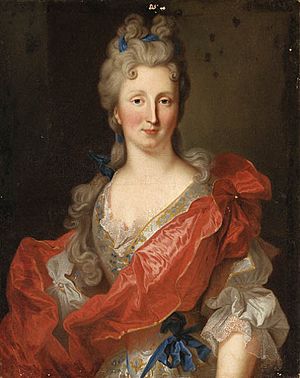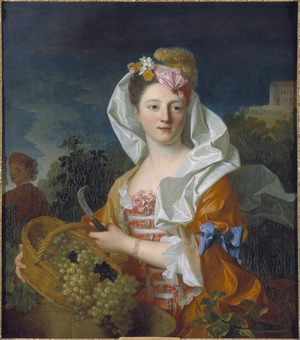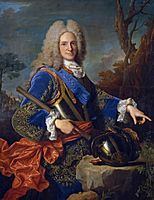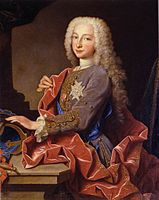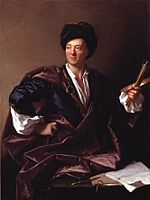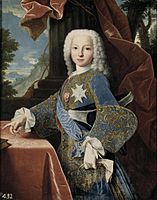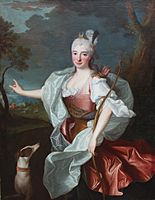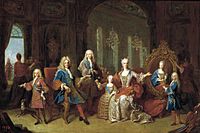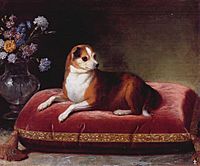Jean Ranc facts for kids
Jean Ranc was a French painter born in 1674. He was known for painting portraits of people. He learned from his father, Antoine Ranc, and a famous painter named Hyacinthe Rigaud. Jean Ranc painted for kings like Louis XV of France in France and Philip V of Spain in Spain. He lived until 1735.
Contents
Jean Ranc's Life
Early Years and Training
Jean Ranc was born in Montpellier, France. His father, Antoine Ranc, was also a portrait painter. Antoine had many famous paintings and taught young artists in his studio. One of his students was Hyacinthe Rigaud, who later became Jean Ranc's teacher.
In 1696, Jean Ranc moved to Paris. He joined Rigaud's art studio to learn more. By 1703, he became a recognized portrait painter at the Royal Academy of Painting and Sculpture. He painted important people like Nicolas van Plattenberg and François Verdier. Even though he wanted to paint historical scenes, he became famous for his portraits.
Jean Ranc became a popular portrait painter for wealthy people in Paris. His paintings were similar to Rigaud's but cost less. In 1715, he married Marguerite Elisabeth Rigaud, who was his teacher's niece.
Moving to Madrid
In 1723, King Philip V of Spain wanted a skilled French painter for his court. He asked for a famous artist like Rigaud. However, Rigaud suggested younger painters who might be willing to move far away. Jean Ranc was chosen because he was talented and had married Rigaud's niece.
Jean Ranc moved to Madrid, Spain, in 1724 with his five children. He hoped to have a very successful career there, as there were no other French portrait painters as good as him. Two more children were born to him in Madrid.
From 1729 to 1730, Ranc also spent a year in Lisbon, Portugal. He sketched members of the Portuguese royal family. His painting style combined Rigaud's soft touch with the strong look of Spanish painter Diego Velázquez. This new style was very popular with King Philip V. The King liked Ranc's portraits of his son, Charles III, better than those by Spanish artists.
Jean Ranc faced some challenges in Spain. Other Spanish artists were sometimes critical of him because he was a foreigner. He also had a rivalry with another French painter, Michel Ange Houasse. In 1734, a big fire destroyed the Royal Alcazar of Madrid palace. The fire actually started in one of Ranc's rooms. After this, Ranc became very sad and had problems with his eyesight. He passed away in Madrid in 1735 at the age of 61.
After Ranc's death, Rigaud was again asked to choose a new official painter for the Spanish court. He recommended Louis Michel Van Loo, who became very successful there.
Jean Ranc's Painting Style
Jean Ranc had a very close connection to Hyacinthe Rigaud. Rigaud was his teacher, and Ranc's father had taught Rigaud. Because of this, Ranc's painting style was very similar to Rigaud's. Sometimes, Ranc's paintings were even mistaken for Rigaud's.
For example, Ranc's portraits of Joseph Bonnier de la Mosson and his wife were once thought to be by Rigaud. But later, they were correctly identified as Ranc's work. This shows how much Ranc's style looked like his teacher's.
In his 1710 painting of Joseph Delaselle, Ranc used Rigaud's way of showing flowing fabrics and relaxed poses. His 1719 portrait of the young Louis XV also looked like Rigaud's earlier painting of the king. Ranc used similar royal clothing, heavy drapes, and columns in his work. When he painted for the Spanish court, Ranc continued to copy Rigaud's style, though sometimes with less natural movement.
Ranc often used military poses and details from Rigaud's paintings. For example, in a portrait of Daniel-François de Gélos, he included a staff with the royal symbol, flowing drapes, and a battle scene.
You can tell Ranc's paintings apart from Rigaud's by looking closely. Ranc often painted very slender hands and sharp, crisp folds in clothing. Rigaud's drapes, however, looked much softer. While Rigaud's faces were very lifelike, Ranc was excellent at showing grand scenes and bright colors in his art.
Gallery
- Jean Ranc's paintings
-
Philip V in 1723 (Museo del Prado)
-
Portrait of the painter François Verdier (1703, Versailles, musée national du château)
-
Philip I of Parma as a child
-
Diana the huntress, in 1715 (private collection)
-
Vertumnus and Pomona (Musée Fabre, Montpellier) – this painting might have inspired some of the tapestry designs by Francisco de Goya, like The Parasol.
-
Portrait of the painter Nicolas Van Plattenberg, known as "Platte-Montagne" (1703, Versailles, musée national du château)
See also
 In Spanish: Jean Ranc para niños
In Spanish: Jean Ranc para niños


